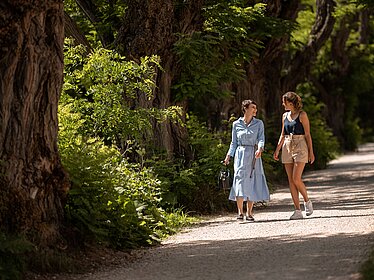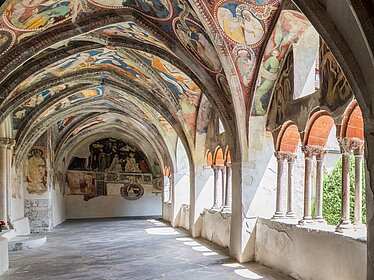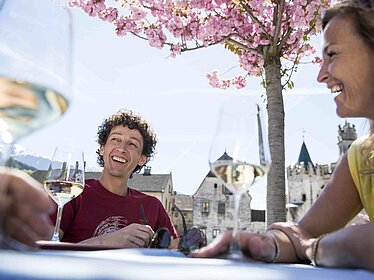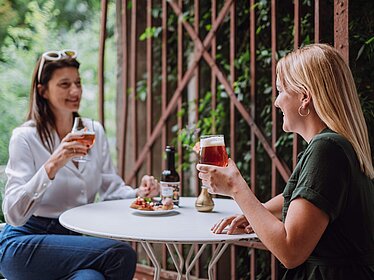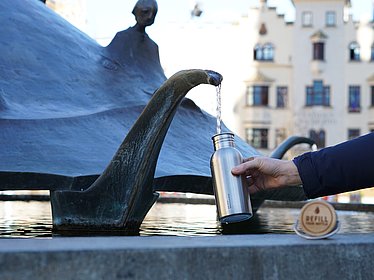Exploring the great outdoors
Urban Vibes
A feast for the senses
My holiday
Menu
Exploring the great outdoors
-
Exploring the great outdoors
- Bike
- Hiking and walking
- Skiing and winter sports
Menu
Urban Vibes
-
Urban Vibes
- Vibrant old town
- Art and culture
- Shopping
- Water
Menu
A feast for the senses
-
A feast for the senses
- White wine
- Local products
- Törggelen harvest festival
- Dining
Menu
My holiday
-
My holiday
- Brixen as a holiday destination
- Arrival and local travel
- The latest from Brixen
- Events
- Holidaying in Brixen
- Home
- Urban Vibes
- Water
- Water
- lovely and fresh!

Of Inns and Stars
You eat well here. And we’re not just saying that. From starred cuisine to farmer’s inns, in and around Bressanone/ Brixen and Chiusa/Klausen, an exciting culinary culture is prospering, which honours tradition while also trying new things.
The year 2006 was drawing to a close, but winter would not come just yet, with the air outside still as warm as in late summer, when MARTIN OBERMARZONER earned his first Michelin star. Soon his entire home town of Chiusa knew. Except him. “Congratulations”,
texted someone. The young chef frowned. His birthday would not be until a few days later. But when his father came home in a somewhat grumpy mood, something finally began to dawn on him. His father grumbled. Why didn’t he tell him about the star? He had been to see the mayor to discuss something about the fire brigade, and the
entire town had congratulated him. It was not until then that the son read about his own distinction in the papers. Even as a small child, Martin Obermarzoner used to play with the frying pans in the kitchen of his parents’ hotel, the Bischofhof in Chiusa. Perched on a hillside, with a view of the idyllic town and the sunlit Säben Abbey. He wanted to be a chef even then. “I never considered being anything else”, he says today, ordering another espresso. His third, to be exact. At ten o’clock in the morning. He went out into the world, training with starred
chefs, telling himself, “I want that, too!” “From that point on, the sky was the limit. If you’re going to aim for something, aim high. Right?” Another sip of coffee. The second star would follow in 2011.

Into the kitchen. Radio on. Together with his wife, Marlis, Martin Obermarzoner runs the hotel—the third generation in his family to do so—as well as the Jasmin, his small but excellent gourmet restaurant. Five or six tables, no more. The finest culinary art. He usually does all the work in the kitchen himself. Cleaning spinach is like meditating to him, he says.
Martin Obermarzoner weaves a spell of the highest culinary quality at the two-star Jasmin restaurant in Chiusa. But the thing about South Tyrol is that a broad variety of places, from a gourmet restaurant to a rustic inn, offer excellent cooking. There is something for every taste there. The region between the Brennero/Brenner Pass and Salorno/Salurn got off to a flying start in culinary terms in the past few decades.
And yet everything used to be very different. This piece of land nestled amidst the Alps used to offer mainly bland farmer’s meals. South Tyrol was the country of poor man’s food, where dumplings and potatoes had to make do as the dish of the day. Tempi passati! The mediterranean, Alpine, and Habsburg cuisines have long since started to influence each other; a generation of young, open-minded chefs has rediscovered the many flavours of South Tyrol, learned to celebrate the joys of simple cooking, invented variations, and enriched it all with exciting new, even international ideas.
Chefs such as ALEXANDER THALER of the Sunnegg restaurant above Bressanone. The restaurant is aptly named: the sun is burning down on the terrace, where Mr Thaler is currently wiping down tables. The view includes the historic town and the Neustift Monastery. A fig tree proudly spreads its branches hanging heavy with fruit. Like Martin Obermarzoner, Alexander Thaler is a third-generation restaurant owner; his grandfather bought it in the 1950s.

“I’ve always been fascifascinated by the work of a chef”, he says with shining eyes, “because it is creative and exciting.”
Paul Huber
He, too, has travelled extensively. He has cooked with Roland Trettl at the legendary Ikarus restaurant at the Hangar-7 in Salzburg; he has been on Italian TV cooking shows. But at some point he wanted to come home, like so many South Tyroleans do. And he wanted to practise what he had learned in the wide world. The Sunnegg is surrounded by vines
and woods; hot steam and fine aromas are mingling in the kitchen. Lenny Kravitz is on the radio. The chef sings along while he is chopping onions. He is preparing classic steak tartare using local beef, with butter and toast. Patrons come from everywhere, locals and tourists, for this dish. “Good, honest cuisine and traditional places”,
says the young chef while he is straight-ening the cutlery in the dining room one last time, “I just love that combination.” The rooms are panelled in old barn wood, a tiled stove in each, black-and-white pictures of the grandparents and great-grandparents on the walls. In the small cellar, Alexander Thaler is producing his own wine. Sylvaner, Kerner, Zweigelt: typical Eisacktal Valley varieties.
Thaler and his restaurant are part of the “Südtiroler Gasthaus” initiative: 34 family-run inns which have committed to maintaining and rediscovering traditional South Tyrolean cuisine as well as the use of regional, seasonal produce. Mr Thaler has his own herb garden and also cultivates courgettes, tomatoes, and much more. The meat comes from South Tyrol, purchased from the local butcher. Like many of his colleagues, he procures other products from the area; from the gardens of the Aspinger farm in Barbiano/Barbian, for instance, which grows more than 500 almost-forgotten varieties of fruit and vegetable. “I don’t need to prepare kangaroo meat or offer wine from New Zealand”, says Alexander Thaler while he is serving up the steak tartare. “We are mindful of regional cycles, seasonal cuisine.”



Thaler and his fellow chefs are banking on new approaches, but they have no ambition to reinvent the culinary wheel. They want to cook like in the olden times—but with an eye to an appropriate mix of the traditional and the modern. Honour tradition but don’t seal yourself off from the new.
That was the goal of PAUL HUBER when he decided to continue to run his parents’ Buschenschank. In South Tyrol, Buschenschänke are farmhouse inns, mostly offering their own products, either seasonally or year-round. “It wasn’t an easy decision. A lot of work went into it. But I knew that if I was going to do it, I was going to do it properly”, he tells us as he pours a glass of home-grown Sylvaner wine in the 250-year-old Stube, or public room, of his Griesserhof farm in Varna/Vahrn, north of Bressanone. “This room is the heart of farmer family life”, says Mr Huber. Who can tell what it has seen? Who can tell what else it is going to see? A young couple at the neighbouring table orders Coca-Cola. The carved figure of Jesus on the cross is glaring down at them from the domestic shrine. The farmer and innkeeper grins good-naturedly. “No coke here”, he says and pours them self-made grape juice instead.
The Griesserhof was first mentioned in 1192. Paul Huber remembers accompanying his grandfather down to Bressanone, selling bread, butter, and speck from a handcart. In the 1980s, the Eisacktal Valley tradition of Törggelen—autumn feasts of local fare, new wine and roasted chestnuts, offered by the region’s many farmhouse inns—and the Buschenschank principle were watered down somewhat. “We want to go back to the roots”, says the farmer. He serves Schlutzer, a type of ravioli filled with spinach, which melt like butter on the tongue. They taste as they must have tasted a hundred years ago in this inn, as they will hopefully still taste a hundred years from now. Every dish tells the culinary tale of a microcosm. And the young couple at the neighbouring table order two more glasses of grape juice.
Origin and future. The eternal cycle of cooking. Night has fallen over Chiusa, the dining room at the Jasmin is filling up. “I wanted to create completely crazy dishes when I was younger”, says Martin Obermarzoner, tossing the pans with a laugh. “A lot of it was juvenile enthusiasm, I reckon. Nowadays I’m more drawn to simplicity. But one thing remains no matter what: the dish must evoke some emotion in the patron.” No sooner said than he sends out the first round of amuse-gueule. Which includes, incidentally, a small bowl of excellent barley soup.
Text: Lenz Koppelstätter
Pictures: Caroline Renzler
Date of publication: 2019


